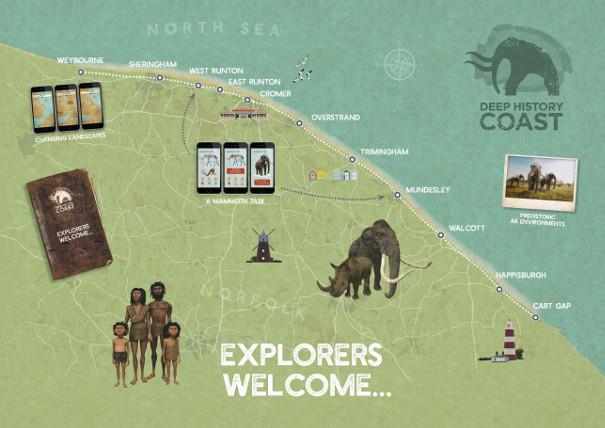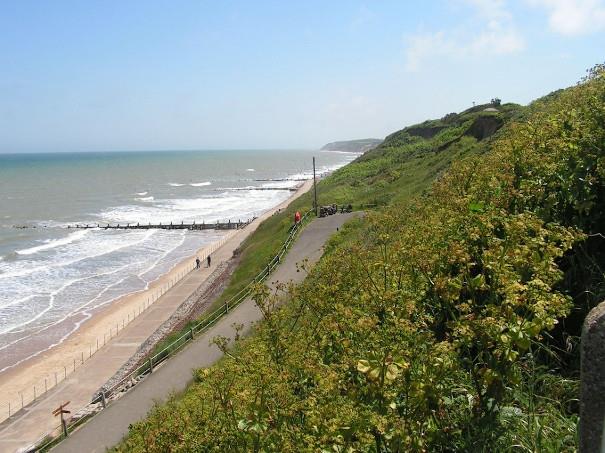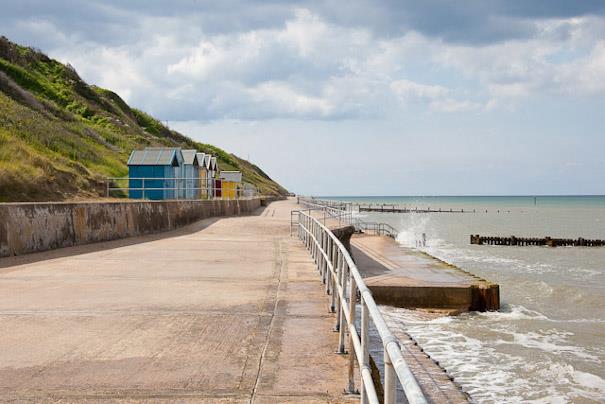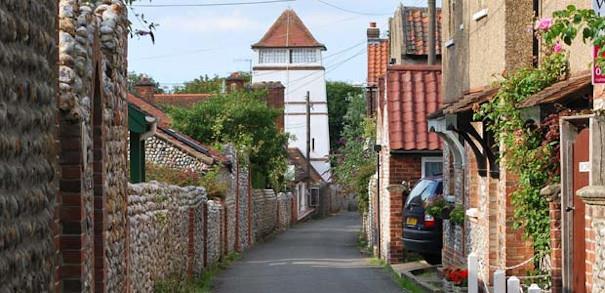North Norfolk's Deep History Coast is a 22-mile stretch of coastline between Weybourne and Cart Gap and is steeped in millions of years’ worth of history. With wonderful beaches, ideal for fossil and artefact hunting and a fascinating Discovery Trail, with fact revealing Discovery Points along the way, there is a lot to discover. There is a free downloadable Deep History Coast App to bring the trail to life linking with the Discovery Points along the way with information and interactive activities.
Through the app, you’ll be able to see the past come back to life and find out what life in Doggerland was like through the eyes of a hominin family, watch animals from 800,000 years ago roam the land and find out the names of any fossils you may find. Discovery Points are located at each of the main villages and towns. Here we focus on Overstrand.

ABOUT OVERSTRAND
Overstrand is a pretty coastal cliff-top village, overlooking lovely sandy beaches and is a short distance from Cromer. The village's history is firmly rooted in the fishing industry and fishing boats are still based here. Sitting on the Norfolk Coast Path, Overtrand is a great place for a holiday, a day on the beach and for those looking to enjoy some walking or exploring the surrounding woodland.

EARLY HISTORY
Overstrand means 'ridge shore' or 'narrow shore' which contrasts nearby Sidestrand. The are was named 'Poppyland' in 1883 after London journalist and travel writer Clement Scott visited Overstrand in 1883; from May to September the fields of wheat and barley that grew here would have been ablaze with their crimson red flowers.
Scott's writings led to a number of London theatrical contacts visiting Overstrand where they bought land in the village and built houses leading to the nickname of 'the village of millionaires' with some grand and unusual properties, dating over several periods.
At the edge of the village is the church of St Martin, built during the reign of King Henry IV in 1399. The church fell into ruins and in 1867 another church was built in the churchyard. It was decided in 1884 that the ruins of St Martins would be rebuilt and the restored church was rededicated in 1914. The interim church was finally demolished in 1951.
The Sea Marge, an elegant Edwardian mansion, was built in 1908 as a country home for Sir Edgar Speyer, a London banker, and chairman and founder of London Underground. The Sea Marge then opened as a hotel in 1935 until 1955, when it became a nursing home. After a restoration programme, it reopened as a hotel in 1996, and today, the Sea Marge has all the comforts of a modern hotel, but retains all of its character.

DEEP HISTORY
Overstrand village is on the Deep History Coast Trail with a Discovery Point by the beach which provides visitors with lots of interactive information about how the area looked millions of years ago. Download the App to find out more about the area's history, as well as play games and identify any fossils you find along the beach.
West and east of Overstrand the broad, ochre-streaked cliffs lean back into the land like threadbare old, lumpy, time worn sofas. The coast here has slumped and slipped for millennia, revealing the fossils that explain its past, and providing a home for the special plants and animals that need live on the rough, bare and sandy pockets these slumps create.
Look towards the sea and you will see close packed, wooden groynes splitting the beach, revetments of jumbled rocks line the base of the cliffs, and a huge, concrete sea wall sits in front of the village, protecting the coastline and village from the sea.
Although coastal erosion brings many problems, it is what makes this landscape special. Fossils have, and continue to be discovered here. Parts of the cliffs are protected by law because of their geology and wildlife importance meaning some sections of the coast are being protected, while others have been left for the sea to strip and shape as it has done since the last ice age.
The gashes of white you can see in the cliffs to the right of the road from the east end of the beach are actually huge chunks of chalk in the wrong place. They are pieces of the 70million-year-old chalk reef, which lies below the sea beyond the beach, that that were ripped out and bulldozed here by glaciers passing over it during the ice ages. Now they sit in a layer of the cliffs that is probably only a million or so years old.
Overstrand's nickname of 'Poppyland' is another link with our deep past. Poppy seeds were almost certainly brought over to Britain by Neolithic settlers who crossed from the European mainland around 4000 years ago, bringing their seed corn with them. In among the ancient strains of wheat the poppy seeds were hiding, waiting to spread their bright-red blanket all the way from Southern Europe and North Africa to England.

THINGS TO DO IN OVERSTRAND
Overstrand still retains its old fashioned seaside charm. Nestled between Cromer and Mundesley, Overstrand is a pretty hidden gem with quiet beach and vibrant village with village shop, post office a couple of pubs, hotels (including AA rosette White Horse Hotel) and a cafe. The Cliff Top Café overlooks the sandy beach and is popular with visitors and people who live here.
If you fancy stretching your legs, walk along the cliff top path, past the Royal Cromer Golf Club, Cromer Lighthouse (built in 1680) and into Cromer. Situated on the Norfolk Coast Path, you can also walk from Overstrand to Trimingham; one of the most picturesque clifftop walks along the trail.

Related
Comments
Comments are disabled for this post.






